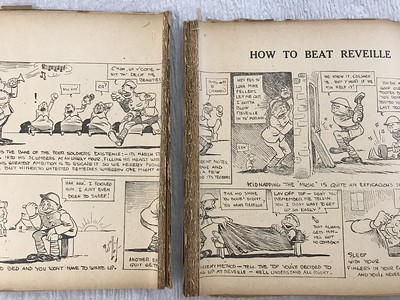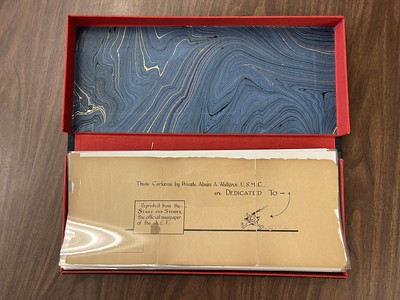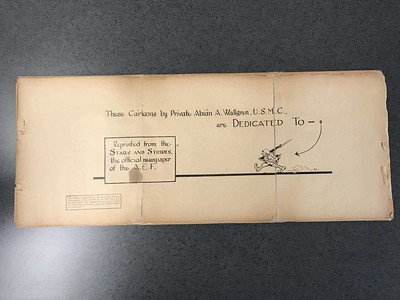The Stars and Stripes is the primary news source for the US military. It was published during World
War I (1914-1918) and then, continuously since World War II. A donation to Special Collections and Archives was made which consisted of a group of cartoons from World War I. The WWI newspaper was published in France by the American Expeditionary Force (AEF) to improve morale. These cartoons were printed on newsprint. The newsprint is roughly 100 years old, and is yellowed and very brittle. These sheets of newsprint are approximately 7” x 17 ½” and were folded over into three sections.
I wanted these newspapers to be used by our patrons and so I paused and thought for some time about an approach to these stacks of brittle newsprint. I was able to humidify the pages in my special humidification chamber… a plastic bucket (into which the paper items are placed) which sits inside a plastic trash can with a small amount of water in the bottom. No water actually touches the items in this chamber, but an overnight session inside the chamber humidifies the paper so it is relaxed, and then can be flattened.
Following humidification and flattening, I used one inch strips of heat set tissue to attach the 3 individual pieces of each page into one page. After this process, I used a deacidification spray to reduce and neutralize the acid levels in each sheet. This spray uses magnesium oxide to neutralize the acid, and leaves an alkaline presence within the paper fibers for preservation over the long term.
I made polyester folders for each sheet in this collection. These folders will allow each patron to safely view each page without damage.
The folders were all placed into a clamshell box.
Honestly, the cartoons are funny in an old time, World War I way. There are lots of jokes about catching bombs with your bare hands, how to treat officers, how to wear your uniform, and trench foot. Really, it’s all jokes about how hard it was. It must have been very tough.

All of the art was created by Private Abian A. Walgren, USMC. This collection is a capsule of one aspect of the war and life in the trenches. It is located in our Archives in the William Kendall Dingledine World War I Collection (MS890).






13 Comments on ‘Conservation of World War I Cartoons’
To be able to sit at your feet and learn your crafty ways . . . way to go Craig!
Thanks Craig–for those interested, the MS890 finding aid is available here:
https://wakespace.lib.wfu.edu/handle/10339/93060
His photo scrapbook and the cartoons are definitely in the queue for digitizing!
A humidification chamber? How amazing! Thanks for letting us peek behind the curtain Craig! Your skills are unique and creative. And so important!
Great work, Craig, you’ve helped extend the life of these so much farther!
Amazing! Thanks for sharing the story behind this collection of cartoons and for all of the TLC you’ve provided to ensure its availability in the future. Looking forward to sharing this item with my comics classes!
Awesome work Craig!!
Amazing, Craig! You are such a talented craftsman. So cool to have this little slice of history preserved–gives a very valuable glimpse of what the soldiers were going through, and coping with.
I love this because my grandfather was in France in WWI and it gives me a glimpse into his life and because we are so lucky to have your skills, Craig!
So cool, Craig. Thanks for sharing your workflow!
Such a great blend of science, history, and librarianship. Thanks for sharing this story, Craig!
What a fascinating process. Thank you for preserving and sharing these cartoons with us, Craig!
This is an impressive and valuable effort in support of work by historians. Congratulations.
This is so cool Craig!